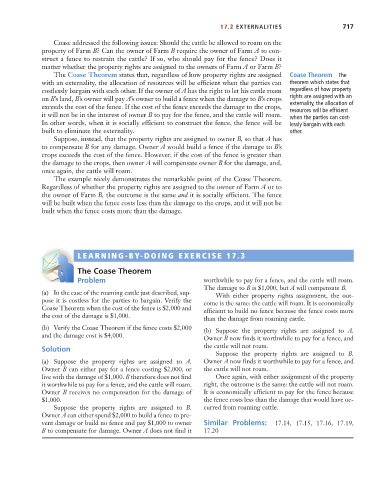Page 743 - Microeconomics, Fourth Edition
P. 743
c17ExternalitiesandPublicGoods.qxd 8/22/10 4:56 AM Page 717
17.2 EXTERNALITIES 717
Coase addressed the following issues: Should the cattle be allowed to roam on the
property of Farm B? Can the owner of Farm B require the owner of Farm A to con-
struct a fence to restrain the cattle? If so, who should pay for the fence? Does it
matter whether the property rights are assigned to the owners of Farm A or Farm B?
The Coase Theorem states that, regardless of how property rights are assigned Coase Theorem The
with an externality, the allocation of resources will be efficient when the parties can theorem which states that
costlessly bargain with each other. If the owner of A has the right to let his cattle roam regardless of how property
on B’s land, B’s owner will pay A’s owner to build a fence when the damage to B’s crops rights are assigned with an
exceeds the cost of the fence. If the cost of the fence exceeds the damage to the crops, externality, the allocation of
resources will be efficient
it will not be in the interest of owner B to pay for the fence, and the cattle will roam. when the parties can cost-
In other words, when it is socially efficient to construct the fence, the fence will be lessly bargain with each
built to eliminate the externality. other.
Suppose, instead, that the property rights are assigned to owner B, so that A has
to compensate B for any damage. Owner A would build a fence if the damage to B’s
crops exceeds the cost of the fence. However, if the cost of the fence is greater than
the damage to the crops, then owner A will compensate owner B for the damage, and,
once again, the cattle will roam.
The example nicely demonstrates the remarkable point of the Coase Theorem.
Regardless of whether the property rights are assigned to the owner of Farm A or to
the owner of Farm B, the outcome is the same and it is socially efficient. The fence
will be built when the fence costs less than the damage to the crops, and it will not be
built when the fence costs more than the damage.
LEARNING-BY-DOING EXERCISE 17.3
S
D
E
The Coase Theorem
Problem worthwhile to pay for a fence, and the cattle will roam.
The damage to B is $1,000, but A will compensate B.
(a) In the case of the roaming cattle just described, sup- With either property rights assignment, the out-
pose it is costless for the parties to bargain. Verify the come is the same: the cattle will roam. It is economically
Coase Theorem when the cost of the fence is $2,000 and efficient to build no fence because the fence costs more
the cost of the damage is $1,000.
than the damage from roaming cattle.
(b) Verify the Coase Theorem if the fence costs $2,000 (b) Suppose the property rights are assigned to A.
and the damage cost is $4,000.
Owner B now finds it worthwhile to pay for a fence, and
the cattle will not roam.
Solution
Suppose the property rights are assigned to B.
(a) Suppose the property rights are assigned to A. Owner A now finds it worthwhile to pay for a fence, and
Owner B can either pay for a fence costing $2,000, or the cattle will not roam.
live with the damage of $1,000. B therefore does not find Once again, with either assignment of the property
it worthwhile to pay for a fence, and the cattle will roam. right, the outcome is the same: the cattle will not roam.
Owner B receives no compensation for the damage of It is economically efficient to pay for the fence because
$1,000. the fence costs less than the damage that would have oc-
Suppose the property rights are assigned to B. curred from roaming cattle.
Owner A can either spend $2,000 to build a fence to pre-
vent damage or build no fence and pay $1,000 to owner Similar Problems: 17.14, 17.15, 17.16, 17.19,
B to compensate for damage. Owner A does not find it 17.20

